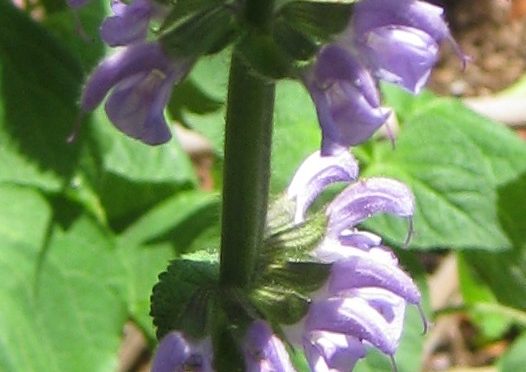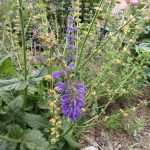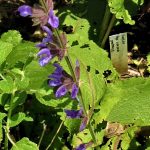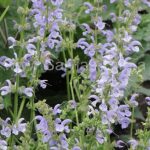Salvia pratensis hybrids: are herbaceous perennials, with rosette growth, 40- 60cm H in flowers of purple/ mauve/ white in spring.
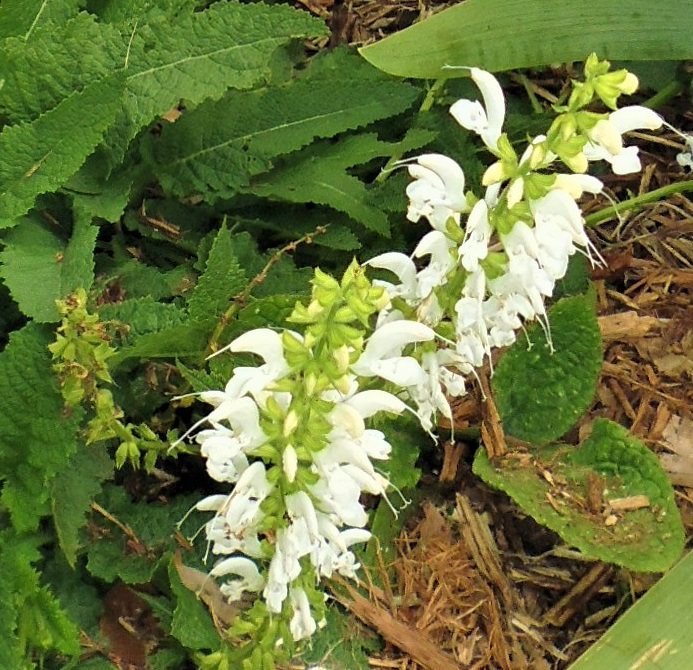
Salvia pratensis hybrids are similar to the Salvia nemorosa hybrids but very different in height and the inflorescence formation.Flowers: are a falcate type, but larger than the S. nemorosa hybrids. The hood is curved with the stigmas being very prominent. The 2 side lobes are long, remaining at the side or fanned out to help open up the throat area.
The bottom lobe is cupped, often with a frill at the end, this acts as a landing place for bees and other pollinating insects.
Flowers are held in whorls of 6-8 flowers, crowded around a strong square green stem at regular intervals. Although the flowers are crowded along the stem, they are not as dense as many of the S.nemorosa hybrids.
Many of the flower stems form panicles with side shoots, all originating at the bottom of the stem. Some flower stems can reach 60-80cm H. On a well formed clump there would be numerous stems produced, making a froth of colour, attracting loads of bees and pollinating insects. Some stems are so tall, they may need staking.
Flowers appear fairly quickly in mid spring, continuing through summer. By mid summer, they have finished, leaving masses of stems with seed.
Calyces: are usually green, but some will colour on exposed sides. They are well ribbed with soft clear hairs with each pointed lobe fanning out to allow the corolla to open. At the base of each whorl are wide green bracts that remain after the flower opens. These eventually fall off.
Calyces will remain on the stem after the flowers have finished, often remaining green, but eventually turning a straw colour, being full of dark round seed.
Leaves: are large, long and wide with very pointed tips and soft crenations along the margins. These form a rosette of leaves at the base of many flower stems. Often the leaves grow sidewards rather than upwards, to shade and smother any small plants close by.
Midribs are prominent with many small veins forming a fissured texture to take any moisture down to the roots.
Large sessile stem leaves appear beneath the side branches of flowering stems.
Salvia pratensis hybrids can form spectacular centre pieces to a garden bed. They can add height and drama to a bed with all the flower stems which can be a froth of colour for a few weeks in early summer and again a mass of stems full of seed at the end of the season. This mass of flower stems is very attractive to bees and pollinating insects.
Plant in a sunny protected position from wind with other small colourful perennials to compliment or add a contrast to some of the colour forms. Ideal for a mixed border with any coloured theme.
In late summer/ early autumn when most of the flowers have finished, collect the seed and cut down all the flower stems. Clear away old leaves and debris around the base,feed lightly and mulch the crown to keep the roots warm during winter.
In late winter/ early spring,just as the leaves are emerging, feed well, watch for snails and slugs and top up mulch to keep the root area cool during the hot dry summer season.
Propagation: usually from seed, but large clumps can be divided , either in early spring before the flowers appear or in autumn before the plants goes down for winter.
Back to Varieties
